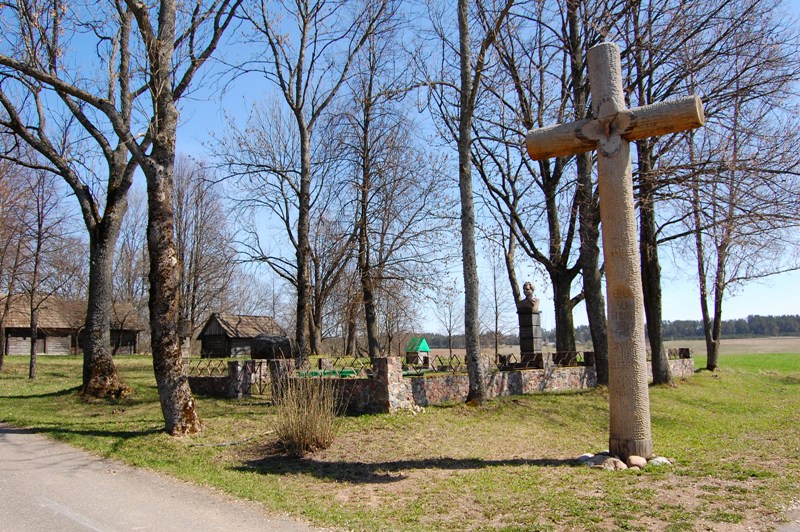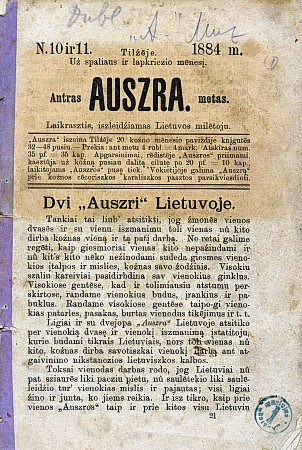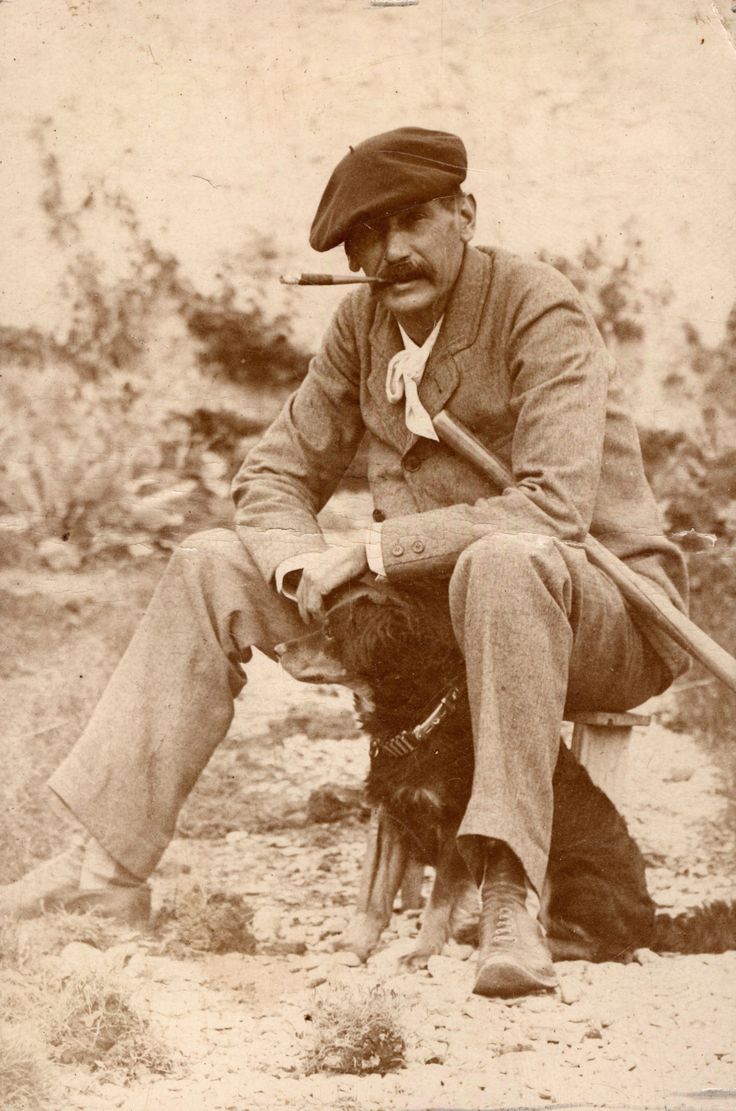|
Antanas Kriščiukaitis
Antanas Kriščiukaitis also known by his pen name Aišbė (1864–1933) was a Lithuanian writer and judge, who served as the chairman of the Lithuanian Tribunal from 1918 to his death. Kriščiukaitis was born in Suvalkija to a family of well-off Lithuanian farmers. Already as a student at the Marijampolė Gymnasium, he started contributing articles to the Lithuanian press. He studied law at the University of Moscow and joined a secret society of Lithuanian students, chaired by Petras Leonas. After the graduation in 1890, he worked as interrogator and judge in Moscow, Mitau ( Jelgava), Tikhvin and Novgorod raising to the rank of State Councillor. He returned to Lithuania in 1918 and became chairman of the Lithuanian Tribunal. He became professor of criminal law at the newly established University of Lithuania in 1922 and advisor to the State Council of Lithuania in 1929. He edited various legal texts, working to create new Lithuanian legal terms and standardize terminology ... [...More Info...] [...Related Items...] OR: [Wikipedia] [Google] [Baidu] |
Suwałki Governorate
Suwałki Governorate (russian: Сувалкская губерния, pl, gubernia suwalska, lt, Suvalkų gubernija) was a governorate (administrative area) of Congress Poland ("Russian Poland") which had its seat in the city of Suwałki. It covered a territory of about 12,300 km². History In 1867, the territories of the Augustów Governorate and the Płock Governorates were re-organised to form the Płock Governorate, the Suwałki Governorate (consisting mostly of the Augustów Governorate territories) and a recreated Łomża Governorate. After World War I, the governorate was split between the Second Polish Republic and Lithuania, mostly along ethnic lines (with an exception of the area in the proximity of Puńsk and north of Sejny). The Polish part, known as Suwałki Region, was incorporated into the Białystok Voivodeship. The Lithuanian region of Suvalkija was named after the governorate. Demographics and economy According to contemporary Russian Empire statis ... [...More Info...] [...Related Items...] OR: [Wikipedia] [Google] [Baidu] |
State Councillor (Russia)
State Councillor (russian: статский советник, statskiy sovetnik) was the civil position (class) in the Russian Empire, according to the Table of Ranks introduced by Peter the Great in 1722. That was a civil rank of the 5th class and equal to those of Brigadier in the Army, Captain-Commander in the Navy, and or Grand Cupbearer in the Court. In 1796, the rank of Brigadier was canceled in the Army, so the rank of State councillor was placed between ranks of Major General and Colonel. Until 1856, the rank gave the right of hereditary nobility; later, that threshold was raised to the 4th class. The rank holder should be addressed as '' Your High Born'' (russian: Ваше Высокородие, Vashe Vysokorodie). Overview State councillors usually served as vice-governors, vice-directors of large departments, or chairmen of the state chamber. In the middle of the 19th century, the rank was the lowest in the top group of state officials. This group (from 1st to 5th grade ... [...More Info...] [...Related Items...] OR: [Wikipedia] [Google] [Baidu] |
Imperial Russian Army
The Imperial Russian Army (russian: Ру́сская импера́торская а́рмия, tr. ) was the armed land force of the Russian Empire, active from around 1721 to the Russian Revolution of 1917. In the early 1850s, the Russian Army consisted of more than 900,000 regular soldiers and nearly 250,000 irregulars (mostly Cossacks). Precursors: Regiments of the New Order Russian tsars before Peter the Great maintained professional hereditary musketeer corps known as '' streltsy''. These were originally raised by Ivan the Terrible; originally an effective force, they had become highly unreliable and undisciplined. In times of war the armed forces were augmented by peasants. The regiments of the new order, or regiments of the foreign order (''Полки нового строя'' or ''Полки иноземного строя'', ''Polki novovo (inozemnovo) stroya''), was the Russian term that was used to describe military units that were formed in the Tsardom of Russi ... [...More Info...] [...Related Items...] OR: [Wikipedia] [Google] [Baidu] |
University Of Saint Petersburg
A university () is an institution of higher (or tertiary) education and research which awards academic degrees in several academic disciplines. Universities typically offer both undergraduate and postgraduate programs. In the United States, the designation is reserved for colleges that have a graduate school. The word ''university'' is derived from the Latin ''universitas magistrorum et scholarium'', which roughly means "community of teachers and scholars". The first universities were created in Europe by Catholic Church monks. The University of Bologna (''Università di Bologna''), founded in 1088, is the first university in the sense of: *Being a high degree-awarding institute. *Having independence from the ecclesiastic schools, although conducted by both clergy and non-clergy. *Using the word ''universitas'' (which was coined at its foundation). *Issuing secular and non-secular degrees: grammar, rhetoric, logic, theology, canon law, notarial law.Hunt Janin: "The university i ... [...More Info...] [...Related Items...] OR: [Wikipedia] [Google] [Baidu] |
Alexander Pushkin
Alexander Sergeyevich Pushkin (; rus, links=no, Александр Сергеевич ПушкинIn pre-Revolutionary script, his name was written ., r=Aleksandr Sergeyevich Pushkin, p=ɐlʲɪkˈsandr sʲɪrˈɡʲe(j)ɪvʲɪtɕ ˈpuʂkʲɪn, a=ru-Pushkin.ogg; ) was a Russian poet, playwright, and novelist of the Romantic era.Basker, Michael. Pushkin and Romanticism. In Ferber, Michael, ed., ''A Companion to European Romanticism''. Oxford: Blackwell, 2005. He is considered by many to be the greatest Russian poetShort biography from University of Virginia . Retrieved 24 November 2006.Allan Rei ... [...More Info...] [...Related Items...] OR: [Wikipedia] [Google] [Baidu] |
The Gypsies (poem)
"The Gypsies" (russian: «Цыга́ны») is a narrative poem in 569 lines by Alexander Pushkin, originally written in Russian in 1824 and first published in 1827. The last of Pushkin's four 'Southern Poems' written during his exile in the south of the Russian Empire, ''The Gypsies'' is also considered to be the most mature of these Southern poems, and has been praised for originality and its engagement with psychological and moral issues. The poem has inspired at least eighteen operas and several ballet Ballet () is a type of performance dance that originated during the Italian Renaissance in the fifteenth century and later developed into a concert dance form in France and Russia. It has since become a widespread and highly technical form of ...s. Outline The poem opens with an establishment of the setting in Bessarabia and a colorful, lively description of the activities of a gypsy camp there: The poem is written almost exclusively in iambic tetrameter, and this regul ... [...More Info...] [...Related Items...] OR: [Wikipedia] [Google] [Baidu] |
Juozas Tumas-Vaižgantas
Juozas Tumas also known by the pen name Vaižgantas (20 September 1869 – 29 April 1933) was a Lithuanian Roman Catholic priest and an activist during the Lithuanian National Revival. He was a prolific writer, editor of nine periodicals, university professor, and member of numerous societies and organizations. His most notable works of fiction include the novel ''Pragiedruliai'' (Cloud Clearing) and the narrative ''Dėdės ir dėdienės'' (Uncles and Aunts) about the ordinary village folk. Born to a family of Lithuanian peasants, Tumas was educated at a gymnasium in Daugavpils (present-day Latvia) and Kaunas Priest Seminary. He began contributing to the Lithuanian press, then banned by the Tsarist authorities, in 1889 or 1890. He was ordained as a priest in 1893 and posted to Mitau (present-day Jelgava, Latvia). In 1895, he was reassigned to Mosėdis in northwestern Lithuania. There he organized the publication of ''Tėvynės sargas'' and the book smuggling into Lithuania. H ... [...More Info...] [...Related Items...] OR: [Wikipedia] [Google] [Baidu] |
Russian Empire
The Russian Empire was an empire and the final period of the Russian monarchy from 1721 to 1917, ruling across large parts of Eurasia. It succeeded the Tsardom of Russia following the Treaty of Nystad, which ended the Great Northern War. The rise of the Russian Empire coincided with the decline of neighbouring rival powers: the Swedish Empire, the Polish–Lithuanian Commonwealth, Qajar Iran, the Ottoman Empire, and Qing China. It also held colonies in North America between 1799 and 1867. Covering an area of approximately , it remains the third-largest empire in history, surpassed only by the British Empire and the Mongol Empire; it ruled over a population of 125.6 million people per the 1897 Russian census, which was the only census carried out during the entire imperial period. Owing to its geographic extent across three continents at its peak, it featured great ethnic, linguistic, religious, and economic diversity. From the 10th–17th centuries, the land ... [...More Info...] [...Related Items...] OR: [Wikipedia] [Google] [Baidu] |
Varpas
''Varpas'' (literally: ''The Bell'') was a monthly Lithuanian-language newspaper published during the Lithuanian press ban from January 1889 to December 1905. Because its publication was illegal in Lithuania, then part of the Russian Empire, it was printed in Tilsit (current Sovetsk) and Ragnit (current Neman) in German East Prussia and smuggled into Lithuania by the knygnešiai (book smugglers). ''Varpas'', with circulation of about 500 to 1,000 copies, played a pivotal role in the Lithuanian National Revival. '' Tautiška giesmė'', one of poems by founder and editor Vincas Kudirka written to commemorate the 10th anniversary of ''Varpas'', became the Lithuanian national anthem.Classic Lithuanian Literature Anthology Editorial staff of ''Varpas'' later started two more specialized publications: more practical ''Ūkininkas'' (''The Farmer'', 1890–1905) for less educated peasants and apolitical '' Naujienos'' (''News'', 1901–1903) for general public. History After the fi ... [...More Info...] [...Related Items...] OR: [Wikipedia] [Google] [Baidu] |
Aušra
''Aušra'' or ''Auszra'' (literally: ''dawn'') was the first national Lithuanian newspaper. The first issue was published in 1883, in Ragnit, East Prussia, Germany (newspaper credited it as lt, Ragainė) East Prussia's ethnolinguistic part - Lithuania Minor. Later it was published monthly in Tilsit (present-day Sovetsk). Even though only forty issues were published and the circulation did not exceed 1,000, it was a significant event as it marked the beginnings of the Lithuanian national rebirth that eventually resulted in an independent Lithuanian State (1918–1940). This period, between 1883 and 1904, when the Lithuanian press ban was enforced by Tsarist authorities, has been referred to as the ''Aušros gadynė'' (the Dawn Period). Due to financial difficulties the printing was discontinued in 1886. History After the Russian authorities denied permission to publish a Lithuanian newspaper in Vilnius, Jonas Šliūpas proposed to publish it in East Prussia, Germany. Howeve ... [...More Info...] [...Related Items...] OR: [Wikipedia] [Google] [Baidu] |
Feuilleton
A ''feuilleton'' (; a diminutive of french: feuillet, the leaf of a book) was originally a kind of supplement attached to the political portion of French newspapers, consisting chiefly of non-political news and gossip, literature and art criticism, a chronicle of the latest fashions, and epigrams, charades and other literary trifles. The term ''feuilleton'' was invented by the editors of the French ''Journal des débats''; Julien Louis Geoffroy and Bertin the Elder, in 1800. The ''feuilleton'' has been described as a "talk of the town", and a contemporary English-language example of the form is the "Talk of the Town" section of ''The New Yorker.'' In English newspapers, the term instead came to refer to an installment of a serial story printed in one part of a newspaper. History The ''feuilleton'' was the literary consequence of the Coup of 18 Brumaire (Dix-huit-Brumaire). A consular edict of January 17, 1800, made a clean sweep of the revolutionary press, and cut down th ... [...More Info...] [...Related Items...] OR: [Wikipedia] [Google] [Baidu] |
Literary Realism
Literary realism is a literary genre, part of the broader realism in arts, that attempts to represent subject-matter truthfully, avoiding speculative fiction and supernatural elements. It originated with the realist art movement that began with mid- nineteenth-century French literature (Stendhal) and Russian literature (Alexander Pushkin). Literary realism attempts to represent familiar things as they are. Realist authors chose to depict everyday and banal activities and experiences. Background Broadly defined as "the representation of reality", realism in the arts is the attempt to represent subject matter truthfully, without artificiality and avoiding artistic conventions, as well as implausible, exotic and supernatural elements. Realism has been prevalent in the arts at many periods, and is in large part a matter of technique and training, and the avoidance of stylization. In the visual arts, illusionistic realism is the accurate depiction of lifeforms, perspective, and the ... [...More Info...] [...Related Items...] OR: [Wikipedia] [Google] [Baidu] |






